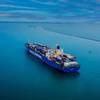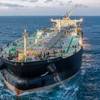By John W. Waterhouse, P.E., President,
Picture this scenario: It's the middle of the night — 3:30 a.m. to be exact. The phone rings — it's a client is calling to say that a vessel is in distress and our services as an engineering firm are needed. "This is no drill." So many factors are at risk - factors that are not to be taken lightly; people's lives, the environment, and property. How will the next few hours or days play out?
One of the key events in my life that helped lead me to my profession as a ship designer was a book about "bad days at sea." The book was The Grey Seas Under by Farley Mowat. If you love the sea then this is a must read. It gives a true taste of salvage operations and the courage of those who wrest disaster from the hungry sea. While some six score years have passed since the events related in that book, some basic truths of salvage are still relevant today.
The quality of an emergency response is dictated by the degree of preparation that a company has done. This preparation should address all levels of the shipping company and their support team, which will likely include insurers, legal advisors, salvage experts, and most likely an engineering firm. At the start of any emergency response there are basic questions that need to be answered:
• What cargo is being carried and how is it stowed onboard?
• Who is in the crew and what is their level of experience?
• What is the status of liquids onboard such as fuel, ballast water, or potable water?
These questions help establish a snapshot of the vessel's condition just prior to the casualty:
• What is the nature of the casualty?
• Is there loss of buoyancy?
• Has a fire incapacitated key systems?
• Are events changing rapidly such as in a collision between vessels?
• Are people hurt or in danger of being injured?
The better the response team understands the casualty, the better they can make intelligent decisions:
• What resources do we need to improve the situation?
• Should tugs be dispatched and how big should they be?
• Is there a specialty such as diving that will be essential to deal with the problem?
At the initial stages of a response it is better to identify resources that later may not be needed than realizing too late that a vital piece is missing:
• What don't we know about the problem?
• What are the lines of communication?
• Who are the key players that will need to be brought into the communication loop?
• What are the criteria for the salvage response to be considered a success?
These questions try to establish the risk and means of dealing with those inevitable unknown factors. The last question reflects a modern age. At the time of the tug Foundation Franklin, described in Mowat's book, success was measured in lives saved and ships recovered. Today, with disasters such as the cargo ship New Carissa and the tanker Prestige, success is measured in terms of oil that wasn't spilled and the ability of politicians to trumpet what they have done for their constituents.
As the engineering firm, our job is to provide information and advice to the salvors. If we are well prepared, the ship's hull will be coded on our computer and we will have reference documents showing the structural members of the ship, its internal compartmentation, and information on the weight distribution of the basic ship. This data allows our naval architects to work from soundings and observations to provide a calibrated picture of what is happening, even if the casualty is many miles away. We can then work through a point of contact to receive observations and to transmit the results of our calculations.
There have been several occasions when we have been called into a salvage job with little or no information. When the small cruise ship Wilderness Adventurer went hard aground in Southeast Alaska, two engineers were dispatched from our office within hours. They carried a computer and whatever documents we could quickly assemble on the vessel. During the plane flight they created a hull model so that by the time they landed and were transported to the site, they could provide useful information. On another occasion, a Japanese fishing vessel went aground on the breakwater off the harbor at Honolulu. Our customer was the tug company who gave us a call and activated our response team. We dug into our files and found a book on Japanese fishing boats (in Japanese) that showed a vessel of similar size and type. From this we were able to advise our customer over the telephone about the approximate weights and amount of lift that might be needed to refloat the vessel.
The moral of the latter tale is that you never know what you will need for a salvage response until it happens. Having a good grounding in Mother Nature and Father Physics is essential as you deal with the problems. The good news is that shipping casualties have continued to decline over the years. Ships are getting safer and there are ongoing efforts, such as the current focus on bulk carrier designs that will continue to improve the safety record. However, as long as people venture out on the ocean, there will be maritime casualties and the need for salvage assistance. We as an industry need to be prepared for the wee hours of the morning when the phone rings and we learn that the person behind the voice on the other end is seeking assistance with their own personal "Bad day at sea."
Sponsored Content
Anschuetz USA: Supporting the U.S. Maritime Industry

Maritime leaders unite to tackle ocean plastic with launch of new alliance: the Maritime Association for Clean Seas

Subscribe for
Maritime Reporter E-News
Maritime Reporter E-News is the maritime industry's largest circulation and most authoritative ENews Service, delivered to your Email five times per week










